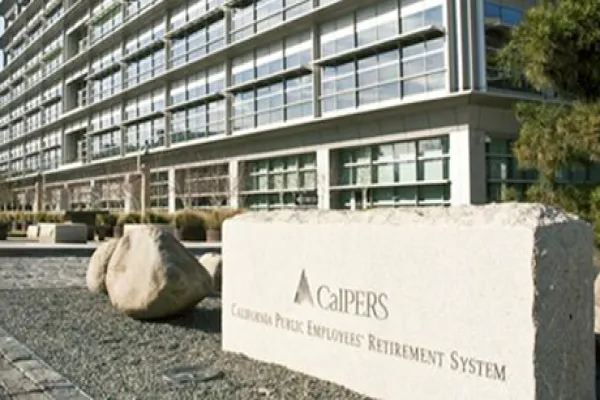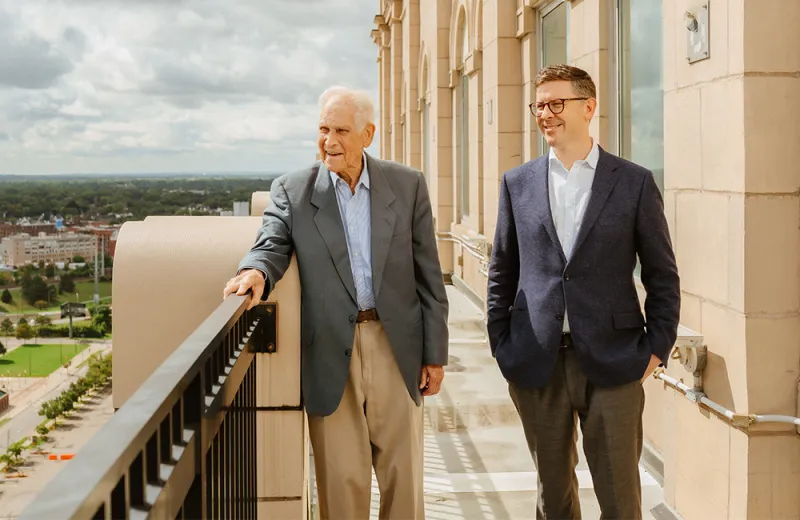
II Photo by Becca Gilgan
(shot on Kodak film)
Rusty Olson and Tom Mucha first met at an unlikely spot — in a diner in Brighton, New York, just outside of Rochester.
The meeting between the former and present chief investment officers of Eastman Kodak Co. took place soon after Mucha began his tenure as CIO in 2011. Tasked with restructuring the pension fund after Kodak declared bankruptcy, Mucha felt that he had quite a bit to learn from Olson, the architect of Kodak’s investment process. Over a typical diner breakfast, the two swapped stories about the portfolio, manager selection, and their respective experiences of being CIO of Kodak.
That breakfast would be the first of of many. “He’s a sounding board to me,” Mucha says today, speaking to Institutional Investor at Kodak’s offices. “I can tell him what I’m going through — and nothing’s ever new, right?”
Olson, seated beside him, demurs. “He was so good himself,” he says of Mucha. “For some reason, he felt that [my advice] was valuable.”
More than 50 years ago, Olson created an investment process, culture, and governance structure that some — including Bridgewater Associates founder Ray Dalio — say rivals David Swensen’s Yale model in both performance and ingenuity.
Mucha and his team at Kodak have successfully built on the foundation Olson laid years ago. In May, the group was voted the Corporate Plan of the Year at Institutional Investor’s Hedge Fund Industry Awards.
Olson’s past work on the pension — and present mentorship of Mucha — certainly has helped Kodak become an award-winning institution. But as a pioneer in alternative investing and a flag bearer for good pension governance, Olson has had an impact far beyond Rochester.
The rest, as they say, is history. “The years I was managing the pension plan were the best years of my life,” Olson, now 90, says. His investments show it.
The portfolio started out with relatively simple index funds and increased in complexity as Olson’s investing prowess grew. Olson added real estate, then venture capital, then oil and gas, then futures, M&A arbitrage, timberland, portable alpha, and high-yield bonds. He eventually wrote a book on the portfolio called The School of Hard Knocks, a nod to the organization’s often unfortunate timing when adding new investments to the portfolio.
In Olson’s early days as an investor, inflation dominated market headlines. Forty years on, it’s much the same — one of many parallels between Olson’s tenure and Mucha’s. Back in the ’80s, Olson responded to rising prices with energy investments, starting with commitments to two Morgan Guaranty commingled petroleum funds.
According to Mucha, some of Kodak’s early energy investments remain in the portfolio today. And he’s added more to the pool since becoming CIO. “I’ve always found upstream private equity energy fascinating,” Mucha says. “I know it’s a fraught topic, but I’m glad we’ve stuck with it because energy partnerships have been some of our best investments.”
Another one of Olson’s innovations was Kodak’s Operation Sweep program, which was led by its consultant at the time, Rogers, Casey & Barksdale. RCB tapped pension funds to cover the costs of a nationwide search for small, unknown investment managers. Olson agreed to join the program on one condition: After the search was completed, RCB would start a commingled fund of the best managers. In the end, Kodak became the first investor in the fund.
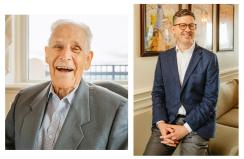
Elements of Operation Sweep remain in Kodak’s present-day manager selection process. Although the pension fund has limited capacity for new investments, the team meets several hundred managers each year — a process Mucha describes as looking under rocks on the chance of finding something good.
What Kodak offers, in Mucha’s estimation, is rare for allocators. Team members are given a high degree of responsibility and freedom to pursue their investment interests, and they have enough latitude from the board to actually get deals done.
That board flexibility is uncommon at corporate pension plans — and it dates back to Olson’s tenure as CIO.
Olson recalls attending Committee on Investment of Employee Benefit Assets meetings and sharing his portfolio strategies with peers. “One response was, ‘You’re doing what? I’d be laughed out of the committee room if I ever brought something like that to them.’ That says something about their committee, but also says something about our committee, and I never lost appreciation for that.”
That early level of diversification and sophistication has drawn comparisons between Olson and Swensen, the Yale CIO who pioneered the “endowment model” of investing. The two came up in the investment industry around the same time, albeit at wildly different types of institutions. They’re considered innovators: Both were early investors in alternative-asset classes like private equity and venture capital, with Olson at some points investing before Swensen.
“I don’t think I concerned myself with conventional practice,” Olson says. “Our portfolio looked so different from most other pension funds, what was the point in looking at other pension funds? We just wanted to make money.”
The two CIOs wrote books on their experiences, and although Olson’s are used in some university courses, it’s Swensen’s that are referenced time and again by allocators.
“Both were great,” Dalio says. “If you made me bet on who would win over the long run, I’d pick Rusty. While David Swensen justifiably gets a lot of credit for making the endowment model and [for] his focus on equities, especially private equities, in my opinion, Rusty was stronger in understanding all asset classes, betas, and all managers’ alphas, and how to put them together to make a good portfolio of return streams.”
Dalio and Olson met back in 1991, when Dalio came to Kodak’s offices to advise the organization on how to structure its debt.
“I had nothing to do with that, but I happened to be right in the office next to the treasurer, and I think [Ray] wanted to see me,” Olson recalls. At the time, he and his team were running scenario tests about how the portfolio would perform in a deflationary environment (the conclusion: badly). At first, Kodak’s solution was to run a fixed-income strategy that was benchmarked against 25-year zero-coupon bonds, with the aim of hedging against deflation while keeping Kodak’s bond allocation low.
Olson recalls sharing the strategy with Dalio, who replied: “Rusty, you’re doing it all wrong. You want to be using futures.”
Dalio walked him through Bridgewater’s Pure Alpha strategy. And to Dalio’s delight, Olson almost immediately saw how it worked.
“He understood how we could take alphas and separate them from betas and put them into portfolios,” Dalio explains. “He intellectually understood, and he allowed us to do it. That was almost off the wall at the time.” Back then, Bridgewater had very few institutional clients, and none the size of Eastman Kodak. In other words, Olson put Bridgewater on the map. And for Kodak, it was worth it.
“It turned out that Ray was the most valuable person we had among our managers,” Olson said. “Bridgewater contributed more value to the fund than all the other good managers we had.”
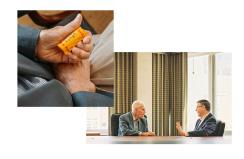
“One of the great ironies or coincidences of my career is that my first training project at Bridgewater was to learn about [Olson] and Kodak,” Mucha says.
During his four-year tenure at Bridgewater, Mucha came to appreciate the importance and reputation of Kodak as a client. Years later, when Kodak launched a search for a new CIO, he found a way to get introduced to Olson, who had long since retired.
While retelling the story, Mucha turns to Olson.
“I’m remembering now what you said to me,” Mucha says. “You said, ‘I had the best job in the company.’ Now I feel the same way.”
Mucha landed the CIO role roughly ten years after Olson had retired. Kodak’s star had faded somewhat — as consumers moved away from traditional film cameras, the company just wasn’t keeping up. Four months after Mucha joined, Eastman Kodak filed for bankruptcy. As part of the reorganization process, Kodak allowed pensioners to either take a lump sum payout or continue to stay invested with the fund. Thanks to the number of lump sum payments taken, Mucha had to liquidate some of the pension fund’s investments.
“It was really a great reset button on the portfolio, on the staff, and ultimately, therefore, on strategy,” Mucha said. “I could create new processes, hire new service providers. It was an unusual chance to almost start over within this sort of long-lived portfolio that was associated with an iconic American brand. I mean, I was incredibly lucky.”
Now, more than ten years after Mucha began his tenure as CIO, he and Olson sit side by side at a wooden table in the Kodak Building’s CEO suite. The investment team doesn’t actually work up here, but with the CEO working from home, showing off George Eastman’s ornate furniture and old Kodak ephemera feels right.
The current and former CIOs detail their relationship and Kodak’s portfolio — all of it — before an office tour, a photo shoot with Institutional Investor’s photographers, and lunch with Mucha’s team.
The rainy day has given way to a breezy, cloud-speckled sky, so we step out onto the 19th-floor balcony overlooking the city of Rochester. Mucha’s assistant, Melissa Higgins, directs our attention across the city to Eastman Kodak’s business campus, where her husband works. The couple met at Kodak, and each will one day benefit from the retirement program that Mucha and his team are now investing on behalf of.
“What I tell my staff is, when you go to Wegmans and you’re in the checkout line and you see an older person paying for their groceries in front of you, there’s a pretty good chance that they are paying for those groceries with, as we call it, KRIP dollars,” Mucha notes. “That’s Kodak Retirement Income Plan.”
After the balcony photo shoot comes a special moment Mucha has planned for his staff and his predecessor. Although the team has heard much about Olson’s legacy — after all, there are magazine covers touting Olson’s work on the walls of their offices — they haven’t yet met the former CIO in person.
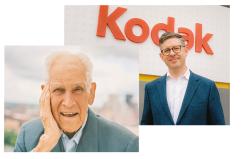
Mucha ushers all of us into a conference room with a massive round oak table, then introduces Olson to his team. We share lunch while Olson and Mucha recount stories of manager meetings and investment mistakes.
The scene brings to mind a moment earlier in the day, when Mucha commented on Olson’s reluctance to share the spotlight with him. “Rusty says, ‘I don’t know why you dragged me along to this interview, because it should be all about you,’” Mucha says. “I guess I disagree, because I think one of the most important things Rusty did was create an institutional culture of accepting this type of investment strategy and investment team. Even though the executives have all turned over multiple times between his era and mine, just that echo, that residual culture of doing it our own way, of pursuing what’s right and what’s true and what’s good for our portfolio, regardless of whether it’s representative of common practice, that’s still part of the Kodak pension ethos. Whatever success I and my team have had over the last decade would’ve been impossible without that base layer of letting a team like ours do what we think is right, not second-guessing, not micromanaging, not comparing to peers or to convention.”
From Mucha’s perspective, this team exists as it does only because of the groundwork Olson laid decades earlier. And now Olson gets to reap the benefits.
“I had a vested interest in my own job,” Olson said. “And I think one of the things I can be satisfied about is that through our 401(k) plan and the pension fund, both of which I was deeply involved with, it’s benefited tens of thousands of Kodak people. They don’t know it. They don’t have to know it, but I know it when I go to bed at night, and you can know it too.”




